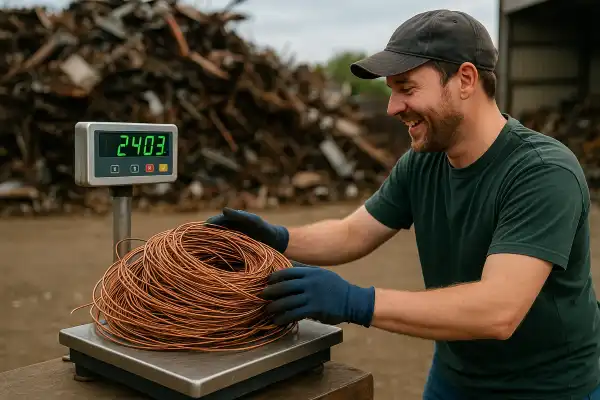Is copper scrap worth anything? This question surfaces regularly among contractors, electricians, and homeowners who accumulate copper materials during renovation projects or equipment replacements. Many people discover they’re sitting on potentially valuable materials without realizing the financial opportunity.
Having spent over a decade processing various metal grades in industrial facilities before transitioning to sustainability writing, I’ve witnessed countless individuals underestimate copper’s recycling value. Recently, while consulting at a manufacturing plant decommissioning old electrical systems, I observed how proper copper identification and separation could mean the difference between modest returns and substantial profits.
Is copper scrap worth anything?
Absolutely, copper scrap is extremely valuable, with current market prices near $4.79 per pound for spot copper and premium grades commanding significantly higher rates. Copper scrap represents one of the most profitable metals in the recycling industry, with No. 1 copper scrap trading at discounts of only $0.12-0.16 per pound from spot prices. So if you’re looking for “Is scrap copper wire worth anything“, you have your answer.

Understanding copper’s intrinsic value
Copper stands as a highly conductive, durable and recyclable metal crucial to electrical systems, construction and green technologies like electric vehicles and renewable energy infrastructure. Unlike many other metals that degrade through recycling processes, copper maintains its properties indefinitely, making recycled copper nearly as valuable as newly mined material.
Goldman Sachs analysis titled “Copper is the New Oil,” predicts copper will approach $51,000 per metric ton by 2025, driven primarily by the global transition to renewable energy and electric vehicles. This surge in demand creates sustained value for copper scrap across all grades.
Copper scrap grades and their market values
Bare bright copper stands as the most valuable grade, referring exclusively to bare, uncoated and unalloyed wire or cable no thinner than 16 gauge in thickness. This grade commands the highest prices because it requires minimal processing before reuse.
#1 copper represents the second most profitable grade, comprising bus bars, clippings, commutator segments and wire of at least 1/16th inch diameter that appears clean, unalloyed and uncoated. Clean copper tubing typically qualifies as #1 copper provided it remains free of fittings, insulation, paint, solder and other materials.
#2 copper includes miscellaneous unalloyed wire, pipe, or solid metal that retains solder, paint, or coating even after cleaning, with minimum copper content between 94-96%. While less valuable than higher grades, #2 copper still provides significant returns for recyclers.
#3 copper represents the lowest marketable grade, containing extensive oxidation, coatings, or mixed metals with copper content around 88-92%. Despite reduced purity, this grade maintains commercial value in the recycling market.
Current market dynamics driving copper values
Demand remains strong, driven by increasing adoption in green technologies, though geopolitical developments such as potential US-China trade tariffs create uncertainties in global scrap copper markets. Chinese buyers have reduced imports of US origin copper scrap, impacting export dynamics and influencing global prices and trading patterns.
The global copper scrap market reached 10.56 million tons in 2024, with projections to reach 13.2 million tons by 2033 at a projected CAGR of 2.38%. This growth reflects increasing recognition of copper recycling’s economic and environmental benefits.
Factors affecting copper scrap pricing
Several variables influence the final price you’ll receive for copper scrap. Each load of copper brought to recycling facilities gets graded by the lowest grade piece in the pile, making proper separation crucial for maximizing returns.
Geographic location significantly impacts pricing, as transportation costs and regional demand fluctuations affect local market rates. Median prices vary by geographic location, volume, and quality, with full-load transactions generally commanding higher prices than partial-load transactions.
Processing requirements also affect value. Stripping insulated copper wire to reveal bare bright copper inside can substantially increase value, though weighing time investment against potential gains remains important.
Environmental and economic benefits of copper recycling
Recycling copper benefits the environment by keeping metal out of landfills and leaving Earth’s wild places unmined, while also offering potential tax exemptions and disposal cost reductions for businesses. Copper recycling conserves natural resources, reduces energy consumption, and minimizes pollution from mining operations that can cause habitat destruction and water pollution.
The economic benefits extend beyond individual profits. Copper scrap costs less than mining and producing new copper from ore, requiring significantly less energy to process than extracting clean copper from raw materials.
Maximizing returns from copper scrap
Successful copper recycling requires proper identification and separation. Sorting copper types, cleaning off dirt or insulation, and removing non-metal components like plastic or rubber attachments makes processing easier and increases scrap value.
When dealing with insulated copper cable, determining whether copper wire inside is bare bright (orange-reddish color) versus tin-coated (silver color) becomes crucial for pricing decisions. Understanding these distinctions helps recyclers make informed choices about processing investments.
Market timing also influences returns. Copper scrap prices change daily, making regular price monitoring essential for optimal selling decisions. Many experienced recyclers track 30-day price averages to identify favorable selling opportunities.
Conclusion
Last month, while helping a local electrical contractor evaluate copper recovered from a commercial building retrofit, we sorted approximately 200 pounds of mixed copper materials. Through proper grade separation and cleaning, what initially appeared to be modest returns transformed into nearly $800 in recycling revenue. With copper scrap prices reaching $6,280 per metric ton in recent quarters, the financial opportunity remains substantial for those who understand grade classifications and market dynamics. Copper scrap definitely holds significant value, making it worthwhile for anyone accumulating these materials to explore recycling options.
